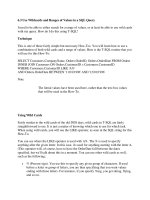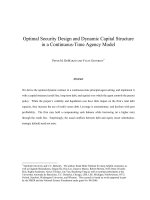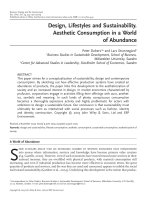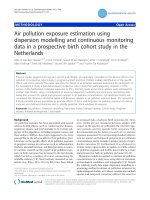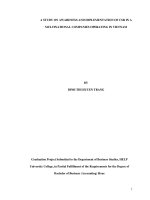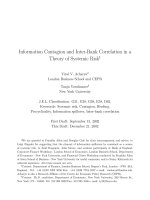Stories, silence and strategies collective memory in a chinese indonesian family
Bạn đang xem bản rút gọn của tài liệu. Xem và tải ngay bản đầy đủ của tài liệu tại đây (696.02 KB, 144 trang )
STORIES, SILENCE AND STRATEGIES:
COLLECTIVE MEMORY IN A CHINESE INDONESIAN
FAMILY
GLORIA ARLINI
(B.Soc.Sc. (Hons.), NUS)
A THESIS SUBMITTED
FOR THE DEGREE OF MASTER OF SOCIAL
SCIENCES
DEPARTMENT OF SOCIOLOGY
NATIONAL UNIVERSITY OF SINGAPORE
2010
STORIES, SILENCE AND STRATEGIES:
COLLECTIVE MEMORY IN A CHINESE INDONESIAN
FAMILY
GLORIA ARLINI
NATIONAL UNIVERSITY OF SINGAPORE
2010
In fond memories of my grandmother
Acknowledgements
This thesis would not be possible without the indispensable help from various people.
In particular, I would like to thank the following extraordinary individuals and
institutions for their invaluable assistance in the course of my thesis preparation:
-Assoc. Prof. Roxana Waterson, my thesis supervisor, who has been most kind and
encouraging throughout my fieldwork and writing period,
-FASS Department of Research and Graduate Studies, for the generous funding
under its Graduate Research Support Scheme
-My parents and younger sister, who have been my most enthusiastic supporters and
without whom my fieldwork interviews would be next to impossible,
-Fairoz Ahmad, my ‗informal supervisor‘, whose encouragement, assistance, critical
insights and utter nonsense have been my pillars of strength,
-Didi Kwartanada, who is ever helpful in entertaining my queries about Chinese in
Indonesia,
-Wilson Tio, who kindly assists in the Chinese translations in this thesis,
-Friends in NUANSA, NDI, and Department of Sociology for your warm friendship,
for memorable times, and for ensuring that I have a life beyond academic pursuit,
and last but not least,
-The Ng family, my keluarga besar about whom this thesis is written, and who have
been so generous as to share with me their memories and stories. I am proud to be part
of our big family.
ii
TABLE OF CONTENT
Acknowledgements
ii
Table of Content
iii
Summary
vii
1
Introduction
1
1.1
Anti-Chinese violence, trauma and victimization
3
1.1.1
Discourse of ethnicity: Chinese Indonesians as the enemy within
6
1.1.2
Masalah Cina and assimilation policy: justifying identity violence 8
1.2
Discourse of Victimization
10
1.3
Resistance and Counter-discourses
13
1.4
A microlevel, non-ethnic focus in studying the Chinese Indonesians
16
1.5
Structure of thesis
19
2
Methods
22
2.1
Family narratives as discourses shaping a family‘s collective memory
22
2.1.1
Family as unit of analysis
22
2.1.2
Family narratives as discourses
25
2.2
2.3
2.4
Respondent profile and nature of fieldwork
27
2.2.1
The Ng family
27
2.2.2
The conduct of fieldwork
29
Data collection and analysis
31
2.3.1
Grounded theory approach
31
2.3.2
Locating resistance, diagnosing power
32
Challenges of native ethnography: reflexivity and positionality
34
iii
2.4.1
An inside outsider
37
2.5
Conclusion
39
3
Stories of Our Violent Past: Evasive Narratives and Silence
41
3.1
Different narratives of violence
42
The victim‘s evasive narratives
43
3.1.1.1 Ellipsis
44
3.1.1.2 Implicit meanings
45
3.1.2
The survivors‘ normalizing narratives
47
3.1.3
The survivor-witnesses‘ nonchalant attitude
50
3.1.1
3.2
Alternative interpretations of resistance
54
3.3
A lack of cultural trauma
56
3.4
Understanding silence
58
3.4.1
69
Between what is said and left unsaid
3.5
Conclusion
61
4
Narratives shaped by Region, Generation and Class
63
4.1
Family definition: A snapshot of the Ng family
65
4.2
Family stories as strategies of resistance
67
4.2.1
Class narratives: reorienting the axis of power
68
4.2.2
Counterdiscourses: rejecting stereotypical Chinese-ness
71
Regional and generational narratives: how positionality matters
75
4.3.1
Rags-to-riches stories from Medan
75
4.3.2
Generation and class factors
78
4.3.3
Regional factor
80
4.3
iv
5
5.1
5.2
5.3
4.3.3.1 Java as centre
81
4.3.3.2 Medan—a new commercial town at the peripheries
83
4.4 Conclusion
85
Gendered Narratives:
Articulating Alternative Femininities and Masculinities
87
Dominant gender discourses shaping the Chinese Indonesians
87
5.1.1
Patriarchal gender order in Indonesia
88
5.1.2
Feminizing the ethnic Chinese minority
90
Resisting emasculation and articulating alternative masculinities
91
5.2.1
Emasculating Chinese Indonesian men
91
5.2.2
The making of heroes: articulating masculinities
94
5.2.2.1 The concept of mengalah
96
Feminizing the feminine
5.3.1
99
The making of heroines:
Resisting women‘s dependency in the family
100
Resisting feminine hierarchy within the family:
Tension between in-laws
104
5.3.3
Modernity, classed femininity and strategies of differentiation
106
5.3.4
Ethnicized femininity and silent resistance
108
5.3.5
Decoding the silence
110
5.3.2
5.4
Conclusion
112
6
Conclusion
114
6.1
Direction for future studies
117
v
Bibliography
120
Annex A
Respondents Profile
Annex B
The Family Tree
Annex C
Interview Guidelines
vi
Summary
This is a sociological study of power and resistance in a single three-generation middle
class Chinese Indonesian family through an examination of its collective memory.
Briefly, this thesis examines various discourses of resistance as reflected in their life
stories and family narratives, as its members negotiate multiple impositions of power in
their everyday lived experiences. The discursive approach seeks to understand how the
family members‘ individual experiences as Chinese Indonesians are articulated within
the family context, and how these ―speak to‖ dominant discourses of Chinese-ness in
Indonesia.
A closer analysis of the family stories reveals multiple structures of power
domination that meet with family members‘ resistance at various sites, both within and
outside the family. In other words, there are various strategies of resistance adopted
by the family members to challenge their subordinate position in society. This is in
contrast to the frequently touted discourse of disempowerment at the community and
national level which locates Chinese Indonesians as passive victims lacking in agency.
To complement the existing body of knowledge about Chinese Indonesians at the
macrostructural level, it is thus necessary to look at the totality of power relations in the
Foucauldian sense, where power relations are diffused in various structures of society,
and is responded by equally diffused bottom-up strategies of resistance.
In every chapter, we will see that inconsistent injunctions about how to be a
Chinese arise in the family stories: should one be proud or ashamed of one‘s Chineseness? Should one be brave and outspoken or fearful and keep a low profile? Should
vii
one try to blend in or display a distinct cultural identity? There is no coherent answer
to these questions, as different stories in the family convey different messages. The
lens of the family is fragmented. Instead of a consistent picture of the worldview its
members have been socialized into, the fragmented lens distorts and diffracts the
worldviews of the family members into rediffusion of images. It is the extent of this
kaleidoscope of representations of being Chinese that this thesis seeks to explore.
This thesis finds that generations, regions, class and gender are among the most
prominent factors in the family that give rise to distinct styles of family narratives,
reflecting a range of strategies of resistance against various structures of power
influencing the Chinese Indonesians. The individual chapters in this thesis will provide
systematic in-depth discussions on what exactly constitutes the heterogeneity of
Chinese-ness in Indonesia, and how they shape the worldviews of different individuals
within the context of a single Chinese Indonesian family. Exploring the particularities
and complexities of a single family‘s collective memory would hopefully provide an
initial step towards uncovering the long suppressed collective memory of the Chinese
Indonesians.
viii
Chapter 1
Introduction
The Chinese in Indonesia have undergone a long history of ethnic discrimination and
persecution. As an ethnic minority, their social history is marred by violent episodes of
mass atrocity, while their life worlds are severely disrupted by the soft knife of policies
and everyday oppression (Das and Kleinman, 2001:1). Being constantly subjected to
outright aggression and symbolic forms of violence, many ethnic Chinese fled the
country, most notably during the mass exodus after the 1960 ban of Chinese shop
houses in rural areas, 1965 killings and 1998 mass rapes and riots (Mackie, 2005:99).
Yet many more decide to remain. For the approximately 6 million Chinese in
Indonesia today (ibid), they live normally as part of Indonesian society. Instead of
living in constant fear as survivors, they interact relatively freely in public spaces. 1
Most are indistinguishable from native Indonesians in terms of culture, speech and
mannerisms. Some even become important office holders in Indonesian government,
such as the present Minister for Trade and Industry, Mari Elka Pangestu, and the former
Minister of Finance, Kwik Kian Gie. In other words, they function as normal social
actors in their everyday life.
However, the everyday is not just ―the site of the ordinary‖ because ―this
ordinariness is itself recovered in the face of the most recalcitrant of tragedies: it is the
site of many buried memories and experiences‖ (Das and Kleinman, 2001:4). Having
survived a dark ethnic history, Chinese Indonesians are continuously ―recreating
1
Admittedly, to some extent, ethnic reservations and boundary-maintenance could still be seen, such as
the formation of gated communities in urban areas. See Wibowo (2001).
1
normality‖ as they ―engag[e] in repair of relationships in the deep recesses of family,
neighbourhood and community‖ (ibid).
This thesis is motivated by the desire to understand what ―normality‖ means to
Chinese Indonesians and how, through spoken words and stories, it is (re)created at the
level of the everyday. As Das and Kleinman (2001:4) ask, ―How does one contain and
seal off the violence that may poison the life of future generations?‖
I seek to
understand how the Chinese remember their community‘s violent past, what impact this
past has on their lives and family, and how—as normal social actors—they perceive
their identity and existence in Indonesia today.
To investigate questions of such exploratory nature, I narrowly focus my study
on a single family to explore the particularities of their experience. Family is chosen as
the unit of analysis because it provides an avenue for stories to be narrated privately. It
provides an alternative discursive space, a space of resistance, away from oppressive
public spaces. This thesis thus looks at how a three-generation middle class Chinese
Indonesian family in Jakarta collectively understands, remembers and transmits their
everyday history.
I find that as members of an ethnic minority, this family copes with ethnic
oppression by engaging in everyday forms of resistance—be it passively through
silence or overtly through empowering family stories. Even within a family, forms of
resistance vary across generations, regions/localities and gender, in response to the
specific structures of power each group experiences. However, to varying extents, they
commonly reject the disempowering construct of ethnic victimization. By discursively
analyzing their life narratives and family stories, I identify patterns of self and family
2
empowerment through a construction of family identities that reflects social status and
agency.
At this point, it is useful to clarify the concepts of violence, trauma and
victimization to understand how they are socially constructed through state and
community discourses.
I find it useful to employ a Foucauldian framework of
discourse and power to bring these themes together and draw the link between
dominant cultural representations of Chinese Indonesians and this family‘s
representations of themselves through everyday narratives. This highlights the fluidity
of power in state-minority relations and brings us to the notion of discursive
resistance—the creation of alternative discourses as a form of bottom-up resistance—
which frames my fieldwork analysis.
1.1
Anti-Chinese violence, trauma and victimization
In state discourses and academic literature, violence, trauma and victimization are often
interlinked to define Chinese Indonesian identity. Anti-Chinese violence encompasses
acts of mass atrocity, everyday discrimination and oppressive state policies directed
towards ethnic Chinese individuals and groups.2 Their repeated occurrence gives rise
to ―a paralyzing sense of being eternally victimized‖ (Ang, 2001b:24) within the
community, resulting in ―a profound sense of unjust victimization…for which there
was apparently no clear, livable explanation, no story to tell except through the
discourse of victimhood itself‖ (ibid:25).
2
See Purdey (2006) Annex A for a list of anti-Chinese violence in 1996-1999 alone.
3
In such a formulation, a causal link is assumed to exist between violence (an act)
and trauma (a resulting mentality), which comes to be interpreted through the lens of
ethnic victimization. The uncritical application of the terms violence, trauma and
victimization without carefully defining them gives the impression that Chinese
Indonesians are always already victims who passively accept their subordination to the
dominant Indonesian state, and who are always trapped within this disempowering
power structure.
Departing from this premise, many studies investigate how state power is
exercised through ideological and repressive means, resulting in widespread social
suffering that gives rise to cultural trauma for Chinese Indonesians. They variously
adopt the perspective of top-down structural domination (Coppel, 1983; Wibowo, 2000;
Purdey, 2006), identity formation (Ang, 2001a, Thung, 1998; Dawis, 2009), or a
combination of both (Hoon, 2008). With the rise of identity politics in the reform era,
young Chinese Indonesian scholars also increasingly explore notions and negotiations
of cultural trauma and ethnic identity to find their place in the society that had all along
victimized them.
There are three problems with viewing Chinese Indonesians as victims suffering
from cultural trauma in response to state violence.
Firstly, violence is assumed
automatically and inevitably to give rise to cultural trauma, ignoring the invisible hands
of the state that shape this process. Secondly, the role of victim and the implied
passivity of victimhood rob the community of agency and camouflage complex
processes of remembering, forgetting, coping and recontextualizing. Thirdly, Chinese
Indonesians are viewed as a single collectivity who presumably perceives the same
4
event in the same manner.
It ignores the existence of various sub-groups in the
community that might interpret and cope with violence differently.
On the contrary, acts of violence alone do not inherently give rise to
victimization or cultural trauma. It is what comes after the event—the representations,
imagination and interpretation of violence—which give rise to socially-constructed
meanings that transcend the particularities of the act. Violence is a multi-stage process,
starting from an act of violence, representation (how the act is portrayed in public
imagination), reception (how violent act and representation is subjectively experienced
by the target) and narrative construction (how violence is told or reported) (Schroder
and Schmidt, 2001:19). Undergoing these stages, violence takes a symbolic meaning
that lives on in the community‘s consciousness—or adversely, traps a person in that
moment of horror—long after the actual event.
Thus it is only through specific forms of synchronized representation,
experience and construction that anti-Chinese violence comes to be perceived as
culturally traumatizing.
According to Alexander, cultural trauma is subjectively
perceived rather than objectively ―happening‖ following acts of violence.
It only
occurs when a group:
feel[s] they have been subjected to a horrendous event that leaves indelible marks upon
their group consciousness, marking their memories forever and changing their future
identity in fundamental and irrevocable ways. (2004:1)
To understand how the Chinese Indonesians are made to ―feel‖ this way about ethnic
violence and identity, we should look at the creation and perpetuation of two related
discourses in the community— a discourse of ethnicity and a discourse of victimization.
5
1.1.1 Discourse of ethnicity: Chinese Indonesians as the enemy within
Estimated to make up between 1.5% and 3% of the Indonesian population, the ethnic
Chinese constitute one of the biggest minority ethnic communities in Indonesia
(Suryadinata, Arifin and Ananta, 2003:101).3 However unlike other minority groups,
they are marked as ―the Other‖ by various policies and measures that have curtailed
their cultural markers of ethnicity. Until a decade ago during which most of these
measures were abolished by the Reformasi government, these included, prohibitions of
Chinese language, religious practices and cultural celebrations in various high-level
national policies.
The consistent repetition of this message results in ethnicity becoming the
primary discourse to describe, and set apart, the Chinese in Indonesia. Discourse, put
simply, is a system of speaking and thinking in which the subjects of interest are
selectively framed and interpreted through particular discursive structures (Mills,
2005:56), in this case, ethnicity. For example, we will see how a specific ―bahasa dan
politik rekayasa‖ (language and political engineering) 4 (Tan, 2008:193) pertaining to
ethnicity was employed by the New Order regime to set apart the Chinese as a distinct
ethnic Other.
Discourse then creates the ―delimitation of a field of objects, the definition of a
legitimate perspective for the agent of knowledge and the fixing of norms for the
elaboration of concepts and theories‖ (ibid:57)—all hinging upon ethnicity—in the
3
There is a likelihood that the number is actually bigger, because the 2000 Population Census that is
used as the basis of this estimation defined ethnicity based on self-identification, which, for the Chinese,
is complicated by ―problems of acculturation and political issues‖ (Suryadinata, Arifin and Ananta,
2003:101).
4
All translations from Indonesian to English, and vice versa, are mine unless noted otherwise.
6
scholarship of the Chinese in Indonesia.
Through strategies of marginalization,
discrimination and stigmatization, ―culturally, ‗Chinese-ness‘ was declared foreign,
while politically and morally it was undesirable to the officially constructed
‗Indonesian Self‘‖ (Heryanto, 2008:74).5 This results in the continued exclusion of the
Chinese in the national imagination, despite attempts towards cultural assimilation.
Ethnic exclusion was an important political tool in the context of emerging
Indonesian nationalism. Triandafyllidou (1998) asserts that in order to foster a unified
Self, a nation needs to go beyond identifying common traits and define their common
enemy. As such, the indigenous Indonesians—the pribumi or sons of the soil—needs
to be defined as the ―authentic native‖ (Heryanto, 1998:100) against an Other outside
the group. As a distinct race that is perceived to originate from beyond the native soils
(despite the fact that many Chinese Indonesians, by then, were born in Indonesia), the
Chinese can never be part of the Indonesian Self. They are always condemned as the
national Other by virtue of their non-indigenous ethnic origin.
In addition, the Chinese are cast as an inferior Other by the deliberate use of the
word Cina to replace the more positive term Tionghoa that was commonly in use in the
Old Order era. Against the backdrop of rising Chinese nationalism and the Dutch
colonial administration‘s tiered racial policy that privileges the Chinese, the term
Tionghoa contained an empowering connotation.
It reflected a global Chinese
nationalist solidarity, while the previously used Cina ―came to be associated with the
inferior status‖ which the Chinese nationalist movement sought to remove (Coppel and
Suryadinata, 1970:102). Thus the conscious decision by Indonesian military leaders in
5
For an overview of such policies see, for example, Coppel (1983), Tan (1999), Lindsey (2005),
Suryadinata (1999 and 2005, especially chapter 7).
7
1966 to revert to the use of the term Cina sought to ―erase the inferiority among our
own people [the native Indonesians], and on the other hand erase the superiority of the
party in question in our nation [the ethnic Chinese]‖ (quoted in ibid:106).
1.1.2 Masalah Cina and assimilation policy: justifying identity violence
Through the discourse of ethnicity, Chinese Indonesians are cast as the enemy within—
a threatening foreign element who are wealthy but have questionable loyalty to the
nation, and are prone to be expropriators of the nation‘s economy by investing their
money overseas (Chua, 2004). A ―myth‖ of Chinese economic dominance is developed
in which the 3% population of ethnic Chinese are said to be in control of 70% of the
nation‘s economy. With the immense wealth of very rich Chinese businessmen like
Liem Swee Liong being frequently emphasized in the mass media, Chinese Indonesians
as a whole come to have imposed upon them racial characteristics of wealth and
exclusivity, and are declared to be guilty of transnational loyalty (Kusno, 2000:165).
As a trickledown effect, terms like non-pri (non-pribumi), konglomerat and
cukong become associated with Chinese Indonesians at the societal level. By the very
words, non-pri defines the Chinese Indonesians as non-Self, effectively negating their
indigeneity while confirming their Otherness in Indonesia. To affirm their economic
dominance, neologisms like konglomerat and cukong emerge to refer to Chinese
Indonesian big businessmen who are ―known to be extremely wealthy and enrich the
corrupt officials in the process‖ (Tan, 2008:245). 6 All three terms entrench cultural
6
In their usage in the Indonesian context, these words have acquired meanings that depart somewhat
from their root words of origin. The word cukong has a Hokkien origin of zhugong ( 主公) which
8
stereotypes of the Chinese as villainous and an external threat to the nation‘s economy
and morality.
In this light, oppression of the Chinese became represented, even justified, as an
act of protest against a malicious enemy.
In the 1960s, the ―Chinese Problem‖
(Masalah Cina) was the subject of various high level government policies and
discussions—a national problem which demanded systematic and practical solutions.7
A Staf Khusus Urusan Cina (Special Staff for Chinese Affairs) was formed in 1967 to
oversee the implementation of these policies, which was then renamed as Badan
Koordinasi Masalah Cina in 1973. The obvious change in the naming, from ―urusan‖
(affairs) to ―masalah‖ (problem); and from ―staf‖ (staff) to ―badan koordinasi‖
(coordinating body) signified a discursive change that reflected the increasing
animosity with which the Chinese were (made to be) viewed in Indonesia.
The BKMC compiled and published in three volumes the list of legislations
pertaining to the Chinese Indonesians, aptly titled Pedoman Penyelesaian Masalah
Cina di Indonesia (Guidelines to solve the Chinese Problem in Indonesia) (Coppel,
2002:131). The discourse was clear: Masalah Cina could only be solved by fostering
the Chinese Indonesians‘ national loyalty through total assimilation, or pembauran total.
Policies that regulate, even suppress, cultural markers of Chinese-ness were rolled out
in quick succession in the first few years of Suharto‘s presidency. Among others, these
include the prohibition on the celebration of Chinese New Year, the dissolving of
means ―boss‖ or ―master‖, but in the local context denotes a ―skilful Chinese businessman who closely
cooperates as a middleman with those in power, especially the military‖ (Roeder, 1973 in Suryadinata,
2005:128). The word konglomerat, an Indonesianized pronunciation of ―conglomerate,‖ is a term that
emerged in the New Order era and was often touted in the media to refer to ethnic Chinese big
businessmen (Tan, 2008:245). In its usage, it is often loosely translated as ―tycoon‖.
7
The clearest representation of this is in the Instruction of the Cabinet Presidium No.37/U/IN/6/1967
concerning ―The Basic Policy for the solution of the Chinese Problem‖. See Suryadinata (2005:230).
9
Chinese organizations, the banning of Chinese media and usage of Chinese scripts, and
the closing down of Chinese schools (Suryadinata, Arifin and Ananta, 2003:74).
The rationale given was that suppressing Chinese culture was the only way
towards naturalizing subsequent generations of Chinese Indonesians.
With their
cultural links and identification with China severed, while loyalty towards Indonesia
was to be structurally and forcefully fostered through measures of pembauran, Chinese
Indonesians were to be intentionally moulded into becoming, so-called, truly
Indonesian.8 By isolating race and ethnicity as the root cause of this national problem
while camouflaging the actual economic problem—an unequal distribution of resources
(Chua, 2004)—the New Order state‘s conceptualization of Masalah Cina constructed a
discursive structure of ethnicity that justified violence against Chinese Indonesians.
1.2
Discourse of Victimization
With deliberate engineering of discursive structures through the establishment of and in
the absence of alternative discourses to contest them, ethnicity becomes writ large as
the main identity, or the single determining factor, that defines the Chinese
Indonesians‘ existence. The problem with this is certainly not in the identification of
this group as an ethnic minority, which is a demographic fact, but in how they come to
be homogenously and exclusively differentiated as the Other by their ethnicity, to the
point that it eclipses any other identities within the community such as those based on
8
Many however argue that these measures towards assimilation ironically bring to prominence the
Chinese Indonesians‘ Otherness, ensuring that they remain ―trapped in the ambivalence of
(non)belonging that the rhetoric of assimilation purports to resolve‖ (Ang, 2001b:39). See for example
Heryanto (1998).
10
class, gender, regional origins, generation, etc. In any social group they belong to,
Chinese Indonesians remain distinct because they are marked by Chinese-ness.
Discourse also ―systematically form the objects of which they speak‖ (Mills,
1997:17). They shape Chinese Indonesians‘ understanding of themselves and their
relations with Indonesian state and society. Consistently reminded of their Otherness,
the discourse of ethnicity indirectly creates a fatalistic attitude in the community, since
many Chinese see themselves as outsiders with no hope for equal treatment in
Indonesia. Some point out that the best way to be a Chinese in Indonesia is to keep a
low profile because it is dangerous to be too outspoken or to enter politics (Hoon,
2008:162). After all, they will always occupy the position of ―losing and always being
in the wrong‖ vis-à-vis the indigenous Indonesians—what Dawis terms the ―kalah dan
salah mentality‖ (Dawis, 2009:163).
This defeatist self-characterization and fatalistic attitude signals a worldview of
victimization among Chinese Indonesians. This mentality is often alluded to in studies
on Chinese Indonesian identity, although the qualitative nature of these studies makes it
impossible to generalize this finding, much less to validate claims of cultural trauma in
the community. Nevertheless, as the reformasi era brings with it greater freedom for
the Chinese, this victim mentality has quickly become a political tool for Chinese
Indonesian community leaders. They are quick to identify victimization as a bond that
strengthens and brings the community together, demanding for reconciliation towards a
more promising and equal future in Indonesia.
In a speech before a multiethnic audience in 2004, the Chairman of
Perhimpunan INTI (Indonesia Tionghoa, Indonesian Chinese Association) Jakarta,
11
―reiterated the victimization of the ethnic Chinese throughout Indonesian history before
calling for reconciliation and the restoration of citizenship rights to the ethnic Chinese‖
(Hoon, 2008:92). This portrayal of Chinese Indonesians as victims of violence is
continuously repeated in speeches and actions of Indonesian Chinese organizations,
such as in the large-scale commemoration of the May 1998 tragedy. This includes the
building of ―Friendship Monument‖ by PARTI (Pergerakan Reformasi Tionghoa,
Chinese Reform Movement) in honour of the May 1998 victims. Taking the form of a
sculpture of two men carrying the Garuda bird, the monument seems to rise phoenixlike from the ashes of the May 1998 flames.
It is not coincidental that the Chinese Indonesians have chosen to use the image
of reconciliation between Chinese and pribumi by way of remembering the May
tragedy (Hoon, 2008:89). According to Ang (2001:21),
the narrativization of victimization and victimhood on the public stage marks an
important moment of self-empowerment for previously subordinated or oppressed
peoples, paving the way for efforts to redress past injustice and present disadvantage.
In this light, the essentializing and over-emphasizing of victimization and
disempowerment seems to act as a leverage to elevate the Chinese Indonesians to a
―moral high ground‖ (ibid:22) as they forgive but never forget what the community has
been through. In other words, discourse of victimization serves a specific purpose for
leaders of the Chinese Indonesian community as they attempt to negotiate power
relations in the post-reformasi era.
However, to do so, it needs to build on and strengthen the polarity between the
powerful oppressor—the Indonesian state/society—and the disempowered victims—the
ethnic Chinese. Despite its empowering purposes, this discourse necessitates Chinese
Indonesians seeing themselves as a community of victims who are made invisible and
12
who are voicelessly trapped at the margins of the Indonesian nation with little avenue to
make their presence known or heard. It emphasizes the history of discrimination and
persecution from which the community has suffered.
In short, the discourse of
victimization solely positions Chinese Indonesians as victims and victims only, thereby
robbing them of agency.9
Discourse structures one‘s thinking, which becomes further solidified as
discursive structures are perpetuated. For Chinese Indonesians, their image of ethnic
Otherness and victimization emerged in response to a state discourse of Chinese-ness,
but as these discursive structures become normalized, they are often mistaken for
structural realities. 10 By appreciating the victimization of Chinese Indonesians as a
discourse that is constructed and perpetuated by the state and the Chinese community
leaders to further their respective interests, the line of inquiry must shift to
understanding the perspectives of the various parties in this chain of power to
appreciate how power shifts as it is asserted and resisted.
The Foucauldian notion of power as circulating in a chain opens up the
possibility of resistance because no power domination can ever be absolute for
resistance is already contained within the notion of power. The question is not just why
9
This does not mean that present studies depict Chinese Indonesians as entirely lacking in agency. From
a Marxist perspective, a subordinate group could resist and even revolt to overthrow hegemonic
domination. However, studies influenced by the discourse of victimization tend to focus on structures of
top-down domination, which obscures the Chinese Indonesians‘ agency and solidifies their status as
helpless victims.
10
In pointing out the discursive nature of Chinese Indonesian victimhood, I am not in the least denying
the material history that testifies to their oppression throughout Indonesian history. History, dark and
bloody, underscores the vulnerability of the Chinese as ethnic subjects of the nation. I follow Foucault in
viewing
that we can only think about and experience material objects and the world as a whole through
discourse and the structures it imposes on our thinking. In the process of thinking about the
world, we categorize and interpret experiences and events according to the structures available
to us and in the process of interpreting, we lend these structures a solidity and a normality which
it is often difficult to question. (Foucault, 1972, 1980, paraphrased in Mills, 2005:56)
13
there is victimization, but from whose point of view this situation is perceived as
victimization. Do the ―victims‖ subjectively see themselves as such, and if not, are
there alternative points of view from which to understand the situation or even resist it?
1.3
Resistance and Counter-discourses
―To be identified as either ‗sufferer‘ or ‗victim‘,‖ says Adelson, ―shackles individuals
and groups to a particular history and burdens them with the responsibility for a history
that was never theirs to decide‖ (2001:78). Moving away from this absolute polarity of
power, I follow Foucault in viewing power as existing and circulating in the
microstructures of society, transferrable from one vehicle of power to another in a
continuous chain of power (Foucault, 1977:194). Thus while discourse perpetuates the
power-holders‘ interests by influencing how marginalized groups perceive reality,
subordinate groups have been known to ―invent and circulate counter-discourses to
formulate oppositional interpretations of their identities, interests and needs‖
(Cheungsatiansup, 2001:63, cited in Dossa, 2009:15).
We would expect the Chinese Indonesians, too, to have their own counterdiscourses in interpreting their ethnicity, identity and marginalization. From Das‘
(2007) anthropological perspectives on violence, individuals experiencing violence
would over time cease to see violence as eruptive or disruptive to their lives. Instead,
they engage in ongoing processes of renegotiating the perceived limits of the social
world as they knew it—one that is shaped by dominant discourses of ethnic
victimization—to produce a new social world out of the debris of the old.
14
Resistance in this study thus refers to discursive resistance through the creation
of counter- or alternative discourses to the dominant discourses of ethnicity and
victimization.
Chinese
Indonesians attempt
to
―remake their
world...[by]
recontextualiz[ing] the narratives of devastation and generat[ing] new contexts through
which everyday life may become possible‖ (Das and Kleinman, 2001:6). Through
everyday stories, we see how this family survives as normal social actors in Indonesia,
thus resisting their discursively ―assigned‖ position as victims and subordinate ethnic
Others in society. By creating alternative discourses to victimization, they are able to
speak of the memory of violent events as part of the fabric of everyday life, instead of
being trapped as victims of these disempowering memories.
Departing from this premise, clearly the understanding of resistance in this
study is somewhat unconventional, although not without precedent. Resistance waged
by Chinese Indonesians is not politically driven, given their status as social and
political pariahs in society. Instead, it assumes the form of identity-based resistance,
that is, resistance against ―the resister‘s expected or attributed identity‖ (Hollander and
Einwohner, 2004:537) as disempowered victims and traumatized community. I wish to
interrogate the extent to which members of this particular Chinese Indonesian family
have resisted victimization and to see how this resistance is manifested in their
everyday narratives.
Also, strategies of resistance by a subordinate group like the Chinese
Indonesians are not likely to be overtly manifested in terms of actions and articulations.
Neither are they always undertaken intentionally and consciously by the resisters
(Hollander and Einwohner, 2004:543). In fact, many acts of resistance that we will see
15

